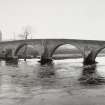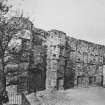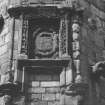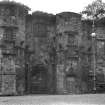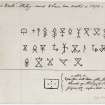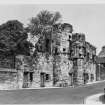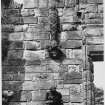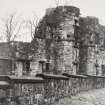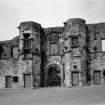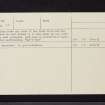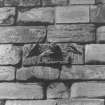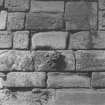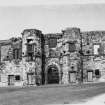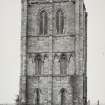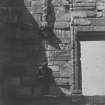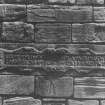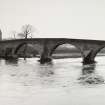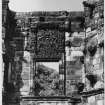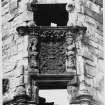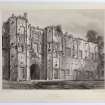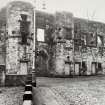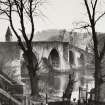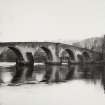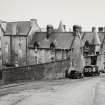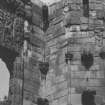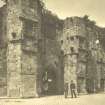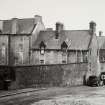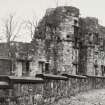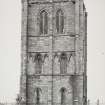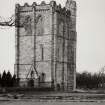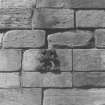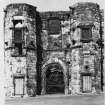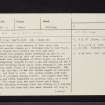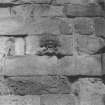Stirling, Mar Place, Mar's Wark
House (16th Century)
Site Name Stirling, Mar Place, Mar's Wark
Classification House (16th Century)
Alternative Name(s) Mar's Work; Mar's Lodging; Mar's Lodge
Canmore ID 46198
Site Number NS79SE 22
NGR NS 79232 93744
Datum OSGB36 - NGR
Permalink http://canmore.org.uk/site/46198
- Council Stirling
- Parish Stirling
- Former Region Central
- Former District Stirling
- Former County Stirlingshire
NS79SE 22 79232 93744
(NS 7 923 9374) Mar's Work (NR) (Rems of)
OS 6"map, (1958).
Mar's Work: What remains of this large and important mansion stands as a roofless ruin in Mar Place.
Only the facade now survives and this has been strengthened and patched where necessary by the DoE. The house as originally laid out must have covered a larger area than now appears at first sight, as traces of two contemporaray cellars at the S end and tusking at the N end of the existing block imply wings running W, the whole comprising three sides of a quadrangular courtyard. The builder was the Earl of Mar who became Regent of Scotland in 1571, and died in 1572. Two carved stones show that work was in progress during 1570-2. The legend that the building was never completed is probably true, as a town plan of 1725 shows only the main block and S wing.
The existing frontage rises two storeys to a denuded wall-head, but the back wall has been trimmed off only a few courses above the level of the first floor and its outer face has been hidden up to this level by soil from the Holy Rude graveyard.
RCAHMS 1963, visited 1954.
As described. In good condition.
Visited by OS (JP) 6 December 1973.
EXTERNAL REFERENCE:
Scottish Record Office:
Letter to James Erskine from his brother to the Earl of Mar 'I'm very pleased my Mother is causing to take down the little Tower and Stables. I confess I'm in the wrong in not sending an answer about the windows of the Drawing room in Stirling............there is a draught of it now enclosed. I would love to have made the pillar betwixt the two windows exactly in the middle of the room if I thought the window could be put nearer the dining room.'
1707 GD 124/15/227/1
Estimate of the value of the large stone tenement called 'Mar's Work' lying at the head of the High Street.
Valuation 4, 800 (Scots).
1735 GD 124/14/14/1
EXTERNAL REFERENCE:
Scottish National Portrait Gallery:
Country Life, March 13th 1909
Antiquarian Observation (1857 - 1861)
Mason's marks from Scottish churches, abbeys and castles recorded between 1857 and 1861 on 29 drawings in the Society of Antiquaries of Scotland Collection.
Publication Account (1978)
The great empty shell which crowns Broad Street is all that remains of a residence built by the Regent Mar in 1570-72. The building was probably never completed although the Earls of Mar Hved in the structure until the end of the seventeenth century. Repairs were carried out on the building so that it could accommodate soldiers in 1715 and the Town Council in 1733 entertained plans to turn Mar's Wark into a workhouse, that is, a place for vagrants, a correction house. Nimmo writing in the 1770s described Mar's Wark as ruinous (RCAHM, 1963, 285). Stones from the structure were apparently used in the construction of a churchyard wall at St. Ninian's and the portion of the Wark which was left standing was probably left so puposely to protect Broad Street from howling winds (Drysdale, 1904, 55). The hundred foot (30. 48m) long structure is marked by its well-balanced architectural design. A central feature of the existing frontage is the archway surmounted by the Royal Arms and flanked on both sides by two octagonal staircases towers bearing the arms of the Regent Mar and those of his Countess (RCAHM, 1963, 287).
Information from Scottish Burgh Survey, ‘Historic Stirling: The Archaeological Implications of Development’, (1978).
Publication Account (1985)
The sad remains of this once large and important Renaissance mansion have been reduced to a single, roughly rectangular block, fronting on to Castle Wynd. Originally there were wings on the north and south which enclosed three sides of a rectangular courtyard, but the foundations of these are now buried under the graveyard of the Church of the Holy Rude (no. 10). Unlike its near neighbour, Argyll Lodging (no. 11), Mar's Work is essentially a one-period building, erected for the Earl of Mar between 1570 and 1572. Mar became Regent of Scotland in 1571, but died in the following year before the house was finished, and it appears that it was never, in fact, completed. In 1733 the Town Council took a lease on the site in order to turn it into a workhouse (cfthe plans to turn Argyll Lodging into an almshouse); by 1777, however, the house was roofless and in a ruinous condition. The principal feature of the building is the lavish decoration of the facade. In contrast with the rich Anglo-Netherlandish style of Argyll Lodging, Mar's Wark reflects the less flamboyant Renaissance style of design that had been introduced to Scotland from France in the 1530s. Mar was doubtless following the fashion set by James V's Palace Block in Stirling Castle (no. 36).
Apart from the twin towers that flank the entrance pend, the facade is flat, but it was richly omamented with carving that is now much weathered. The decoration includes: heraldic and inscribed panels, initial letters and dummy gargoyles in the form of cannon. High above the door archway there is a large heraldic panel which, amongst other devices, bears the royal arms of Scotland, indicating that Mar was a Crown vassal, thus entitling him to place the royal arms, in this case those ofJames (Jacobus) VI, above his own.
Information from ‘Exploring Scotland’s Heritage: The Clyde Estuary and Central Region’, (1985).
Watching Brief (April 2005)
NS 7922 9377 A watching brief was undertaken in April 2005 at the Mar Lodge Cemetery during remedial work following a wall collapse. These works followed a programme of test trenching in January and February 2005 under the supervision of Lorna Main (Stirling Council). The test pits indicated a significant spread of random skeletal material to depths below 2m, with no obvious intact burials.
The area to be investigated comprised the site of an old roadside tenement, believed to have been partly demolished in the last quarter of the 19th century, and the ruins of which have been incorporated into the Mar Lodge Cemetery. The building appears to have been destroyed by the process of demolishing the roadside wall to gain entry, and subsequently gutting the interior, leaving only the N, W and S exterior walls standing. A new roadside wall was then constructed and the empty interior backfilled with a thick deposit of graveyard-derived debris. The position of the tenement is now represented by a raised platform of soil and debris, 3.5m above both the local street level to the E and the gardens of the Valley Lodge to the N. This new surface over the tenement ruins is possibly the same level as the tenement garden on the W side of the ruin and is certainly equivalent to the cemetery ground surface.
Further excavation revealed more human remains, but no intact burials. For the most part, only the dominant forms comprising long bones, pelvises and skulls were present. The minor bones were possibly left in situ, or perhaps the rest of the bones lie elsewhere in the main infill deposit.
The structures uncovered or further exposed by these works consisted of parts of the two remaining tenement walls to the N and W, as well as the new roadside wall to the E and the large garden N side revetting wall.
D Stewart 2005
Sponsor: Historic Scotland
Kirkdale Archaeology
Audits (November 2015)
NS 79232 93744 (NS79SE 22) An inventory of this collection was undertaken in November 2015. The three large corbels have been stored at the Kerse Road depot in Stirling for a number of years. The corbels are worked in a very hard, medium-grained sandstone, and the most complete of the three is carved with a human demi-figure, the head of which is missing. The arms are bent, and the hands are holding a scroll carved in low-relief with the date 1572 carved in low relief. This was the date of decease of John Erskine, 1st Earl of Mar, and may also have been the year in which Mar’s Lodging was completed (a building period of 1570–72 is given in JS Fleming, ‘Regent Mar’s Ludging, Stirling’). Details of the costume are still relatively clear, with the figure wearing a close-fitting doublet with buttons on the front, slightly puffed shoulders, and with a scalloped lower edge. This and other inventories of carved stones from Historic Environment Scotland’s properties in care are held by the Collections Unit. For further information please contact
collections@hes.scot.
Mary Márkus – Archetype
(Source: DES, Volume 17)


















































